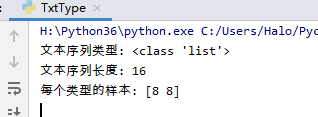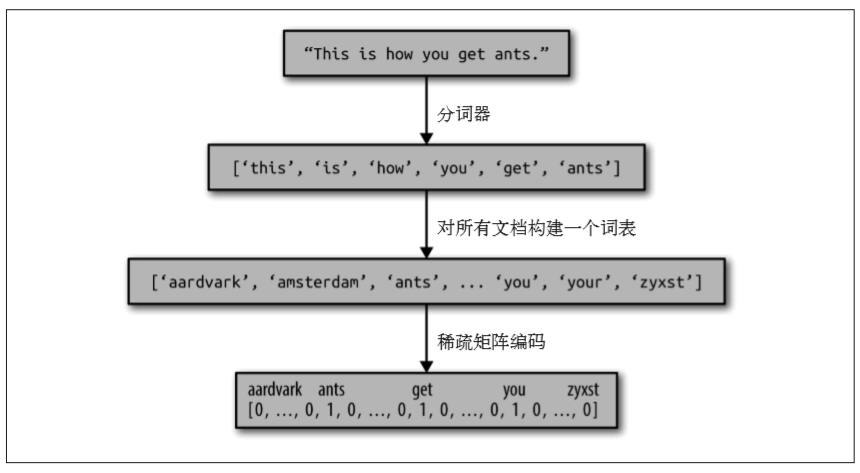第一天学习进度--文本处理基础知识学习
参考教程--python机器学习基础教程
首先在对应目录创建一个文件夹,里面放上对应分类名称(非中文)的文件夹,这个步骤是要读取对应类型的数据。
结构如下图所示:

我在txttype中放置了两个分类的文件夹,每个类别的文件夹中放置了对应类型的文本(数量不限),每个需要训练的语句都单独作为一个文本,文本的名称不做具体要求。
在python中写入对应的代码:
from sklearn.datasets import load_files import numpy as np
#加载数据集
reviews_train = load_files(r"C:\Users\Halo\Desktop\1.6项目开发过程\txttype")
# load_files返回一个Bunch对象,其中包含训练文本和训练标签
text_train, y_train = reviews_train.data, reviews_train.target
print("文本序列类型: {}".format(type(text_train)))
print("文本序列长度: {}".format(len(text_train)))
# print("text_train[1]:\n{}".format(text_train[1]))
#数据清洗
text_train = [doc.replace(b"<br />", b" ") for doc in text_train]
print("每个类型的样本: {}".format(np.bincount(y_train)))
可以发现对应的文本文件已经被正确读取

接着进行第二步,将文本数据转化为词袋
计算词袋在书中的步骤原话为:
计算词袋表示包括以下三个步骤。
(1) 分词(tokenization) 。将每个文档划分为出现在其中的单词 [ 称为词例(token)],比如 按空格和标点划分。
(2) 构建词表(vocabulary building)。收集一个词表,里面包含出现在任意文档中的所有词, 并对它们进行编号(比如按字母顺序排序)。
(3) 编码(encoding)。对于每个文档,计算词表中每个单词在该文档中的出现频次

将上述的过程合并之后:
from sklearn.feature_extraction.text import CountVectorizer bards_words =["The fool doth think he is wise,", "but the wise man knows himself to be a fool"] #切词 vect = CountVectorizer() vect.fit(bards_words) print("Vocabulary size: {}".format(len(vect.vocabulary_))) print("Vocabulary content:\n {}".format(vect.vocabulary_)) #词袋应用 bag_of_words = vect.transform(bards_words) print("bag_of_words: \n{}".format(repr(bag_of_words.toarray())))
上述是对于该用法的简单应用,下面将配合参数调节对数据进行读取。
可以先获取前20个特征
#切词并获得词袋 vect = CountVectorizer().fit(text_train) #应用词袋 X_train = vect.transform(text_train) print("X_train:\n{}".format(repr(X_train))) #获得文本特征 feature_names = vect.get_feature_names() print("特征数量: {}".format(len(feature_names))) print("前20个特征:\n{}".format(feature_names[:20]))
运行结果:

接着对模型进行评估:
from sklearn.model_selection import cross_val_score
from sklearn.linear_model import LogisticRegression
#交叉验证对LogisticRegression进行评估 scores = cross_val_score(LogisticRegression(), X_train, y_train, cv=5) print("平均交叉验证精度: {:.2f}".format(np.mean(scores)))
运行结果:

在利用交叉验证调节正则化参数C:
#交叉验证调节正则化参数C from sklearn.model_selection import GridSearchCV param_grid = {'C': [0.001, 0.01, 0.1, 1, 10]} grid = GridSearchCV(LogisticRegression(), param_grid, cv=5) grid.fit(X_train, y_train) print("最好的交叉验证分数: {:.2f}".format(grid.best_score_)) print("最好参数值: ", grid.best_params_)
运行结果:

接下来将数据应用到实际的测试集合上上看看该性能指标:
#加载测试集 reviews_test = load_files(r"C:\Users\Halo\Desktop\1.6项目开发过程\txttest") text_test, y_test = reviews_test.data, reviews_test.target print("测试集数量: {}".format(len(text_test))) print("文本序列长度: {}".format(np.bincount(y_test))) text_test = [doc.replace(b"<br />", b" ") for doc in text_test] #在测试集上评估参数泛化性能 X_test = vect.transform(text_test) print("测试集评估参数泛化性能:{:.2f}".format(grid.score(X_test, y_test)))
运行结果:

若数据过多,则可以对数据进行清洗:
#集合清洗 vect = CountVectorizer(min_df=5).fit(text_train) X_train = vect.transform(text_train) print("min_df: {}".format(repr(X_train))) feature_names = vect.get_feature_names() print("前50个特征:\n{}".format(feature_names[:50])) #再次用玩个搜索看模型性能 grid = GridSearchCV(LogisticRegression(), param_grid, cv=5) grid.fit(X_train, y_train) print("最好交叉验证分数: {:.2f}".format(grid.best_score_))
运行结果:





